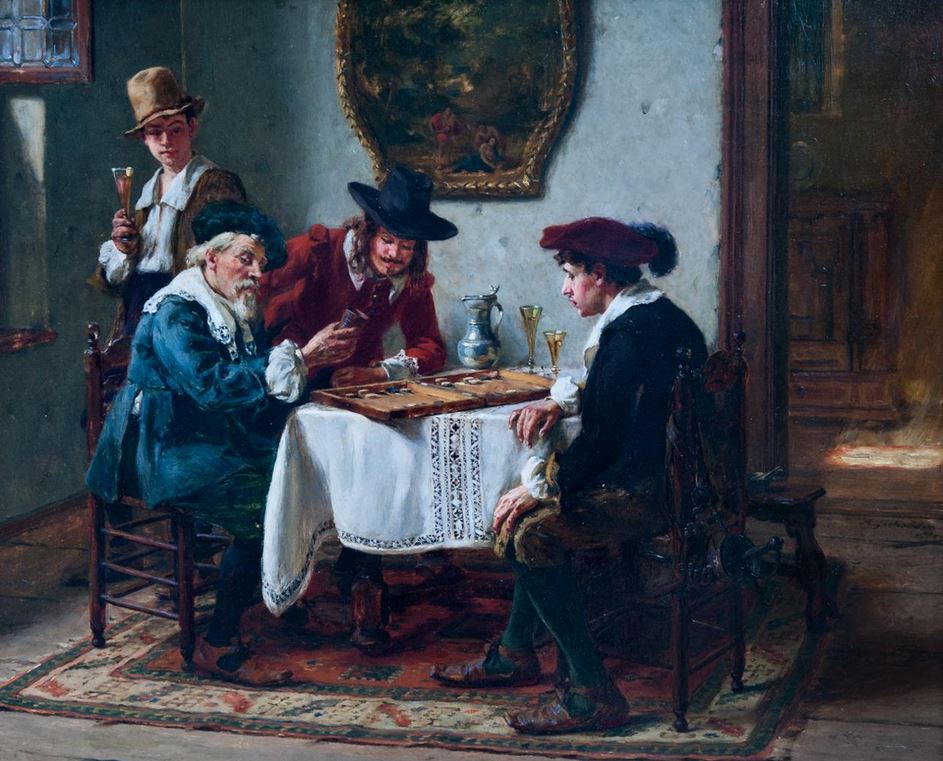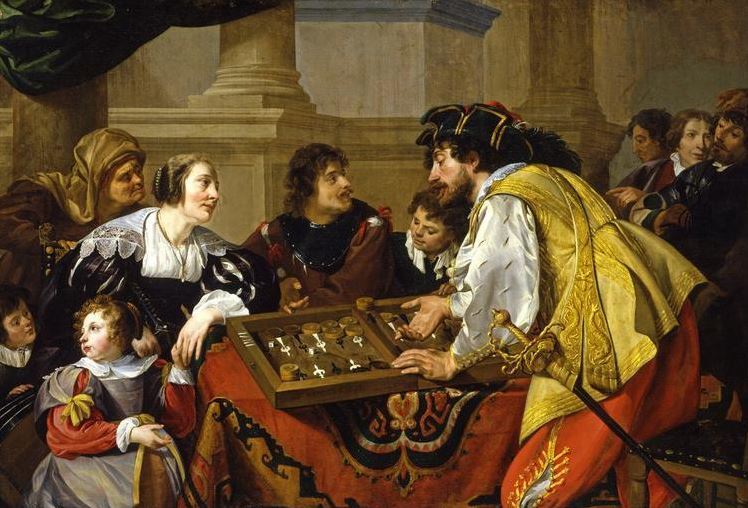Last updated on July 13, 2024
A backgammon chouette is a variant of backgammon for three or more players. Traditional backgammon is strictly a two-player game, so if you are in a group of odd-numbered players, someone is always going to be sitting out on a game. Chouettes offer fun, sociable, and exciting games. It is easy for players to step in and out of a chouette after each game. A chouette is played on a single backgammon board according to standard rules. A chouette is generally played in the same way as backgammon money play. There is no match score, one game is completed, the scores are tabulated, and another game begins. The positions of the players are rotated after each game depending on the result. This Deluxe Backgammon post for beginners assumes knowledge of backgammon rules, scoring and the doubling cube.
A chouette is the most common and popular variant of backgammon. It is played by three or more people, usually one person, known as the Box, against the other people, known as the Team. The game is played on a standard backgammon board and has the same rules as the traditional game. It appeared around the 1970s when backgammon was extremely popular and was played in many households and clubs. Because it can be played by 3 or more people at the same time, it gave players the chance to compete, rather than just sitting and waiting for the next game.
Box vs the Team
In a chouette, one player, called the Box, plays a game of backgammon for points against a Team of other players headed by a Captain. The Captain rolls the dice and moves the checkers on behalf of the Team. The following description contains the basic rules for chouettes. There are many variations to these rules. Every chouette is likely to have its own set of rules. Newcomers to a chouette should take the time to learn the local rules.
To start a chouette, each player rolls one die and in the event of a tie, there is a reroll. The player with the highest roll becomes the Box and plays against all of the other players who form the Team. The player with the second-highest roll becomes the Captain of the Team. The Captain rolls the dice and makes the moves for the Team.
If the Box wins a game they remain in the Box position and they collect the stakes from each player in the Team. Then the Captain forfeits their roll and moves to the back of the Team and the next player in the Team steps in as Captain for the next game. When the Team wins a game, each Team member collects the stakes from the Box. The Captain of the winning Team then becomes the new Box. The losing Box joins the Team at the end of the Captaincy queue. Players can leave or join a chouette at the end of each game. A new player always joins the Team and starts at the bottom of the Captaincy queue.
Common optional rules
Consultation
Typically the Box is playing alone against the Team and is not able to take consultation. However, in some large chouettes the Box may take on a partner and consultation may be allowed under local rules. Some chouettes do not allow consultation and the Captain must make all of the decisions regarding the team’s move. However, in some chouettes, they may consult freely as to how rolls should be played. A common compromise permits Team consultation only after the cube has been turned. In a chouette, too much discussion and consultation can slow up the game. The Captain should only ask for advice when they are really in doubt as to the correct play. The Team members should really only give advice when they think the Captain is making a significant error. In most chouettes, the Captain has the ultimate right to make the decision regarding any particular move.
The doubling cube
Single cube games
A chouette may be played with either a single doubling cube or multiple cubes where each Team member has a cube. In a game with a single cube, the only decision that the members of the Team make individually concerns takes. If the Box doubles, each Team member can decide on his own whether to take or reject the offer. The players who reject the cube each pay the relevant stakes to the Box and leave the game. A player who has dropped out of a game should no longer offer consultation to the Team. If the Captain drops out while there are others on the Team who wish to play on, the Captaincy is taken by the next Team member in the Captaincy queue. The previous Captain drops to the bottom of the queue.
One common situation is when most members of a Team reject an offer of a double from the Box and one player from the Team takes it. This leaves the game in a situation where most of the Team is now on the sidelines and out of the game. There is often an optional ‘majority rules’ clause in place for this scenario so that the lone player is forced to accept the rejection of the majority. This prevents the situation of a majority of the Team not having an interest in the remainder of the game.
Multiple cube games
It is common in most chouettes for each member of the Team to have their own doubling cube. The Box can double the individual Team members, and each Team member can decide whether and when to double the Box. If there are multiple cubes in play, it is possible for the Box to win against some members of the Team whilst losing against others. In this situation, the usual rule is that a player retains the Box only if they defeat the Captain. Should the Captain decline to accept an offer of a double and the Box and other Team members accept, the Captain loses their position and forfeits to the next player in the Captaincy queue.
Tips for chouettes
Learn the local rules. Every chouette will have its own set of rules about the consultation, the Captaincy queue or the cube. Not knowing the rules can cost you dearly, so ensure you understand the rules before the start of play.
Compete against better players and watch, listen, and learn. Playing regularly against weaker players will not improve your play. It might be fun to win a lot of your games, however, you aren’t going to learn anything and possibly may pick up some bad habits. You can learn from the better players by observing their moves and following their doubling decisions. Even just observing as a spectator gives you a chance to learn from more experienced players.
A backgammon “tell” is an action, either physical or verbal, that players make at the table that gives away information about a player’s state of mind. It is important to minimise your own tells, but also important to observe other player’s tells and exploit that advantage. Try and note how players behave with cubes, double cubes, high cubes, etc. to know in advance if opponents are likely to take or reject a cube. Since you can take advantage of a player’s tells, it makes sense that they can do the same in return.
Related content
How to play backgammon chouette at wikiHow.



I have been playing backgammon socially for years, but this is the first time I have heard of a backgammon chouette. I gave it a try with some friends, it takes a while to get used to it, but it is great fun. it means everyone can be involved rather than just being a spectator. Great article, thanks.
Hi Bel, you are 100% correct, playing a backgammon chouette takes some time to get used to, but as you say more people can get involved in each game. Also, remember you can add your own local rules to each session. Take a look at our post on how to improve your backgammon game, you can apply these concepts to either a normal game of backgammon or a chouette. Thanks for taking the time to comment, Jason
The chouette takes a little while to get used to, but it is a great way to play backgammon in a group. Lots of fun! Thanks.